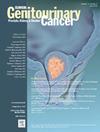2020年至2023年美国转移性激素敏感疾病后转移性去势抵抗性前列腺癌患者的真实世界治疗模式和生存率
IF 2.7
3区 医学
Q3 ONCOLOGY
引用次数: 0
摘要
目的:研究美国转移性激素敏感性前列腺癌(mHSPC)进展为转移性去势抵抗性前列腺癌(mCRPC)患者的治疗模式和生存率。方法:在2020年1月1日至2023年6月30日期间诊断为mCRPC的患者回顾性地在ConcertAI NLP360™电子病历(EMR)数据库中进行鉴定。纳入标准为既往诊断mHSPC和≥1次EMR≥12个月mcrpc前和≥6个月mcrpc后。结果:在609名确诊患者中,mHSPC最常见的既往治疗是单独雄激素剥夺治疗(ADT) (53%);其他包括ADT加阿比特龙(ABI;19%), ADT加非abi雄激素受体途径抑制剂(ARPI;18%)和ADT +多西紫杉醇(10%)。总体而言,mCRPC最常见的一线(1L)治疗是非abi ARPI (37%;最常见的是恩杂鲁胺[24%])、ABI(25%)和化疗(22%)。对于接受ADT单独治疗或ADT加多西他赛治疗mHSPC的患者,这些也是最常见的1L mCRPC治疗。在接受ADT加ABI或非ABI ARPI的mHSPC患者中,分别有50%和40%的人也接受了mCRPC的ARPI 1L。在ADT联合治疗mHSPC后,1L化疗治疗mCRPC的比例(24%-41%)高于单独ADT治疗mHSPC的比例(12%)。mCRPC诊断后的中位真实总生存期为27.2个月,1L治疗后的中位真实总生存期为20.8个月。结论:在目前的临床实践中,从mHSPC到mCRPC的背靠背ARPI使用是常见的,并且存活仍然存在本文章由计算机程序翻译,如有差异,请以英文原文为准。
Real-World Treatment Patterns and Survival in People With Metastatic Castration-Resistant Prostate Cancer Following Metastatic Hormone-Sensitive Disease Between 2020 and 2023 in the United States
Purpose
To examine treatment patterns and survival in people with metastatic castration-resistant prostate cancer (mCRPC) previously progressing from metastatic hormone-sensitive prostate cancer (mHSPC) in the United States.
Methods
People diagnosed with mCRPC between January 1, 2020–June 30, 2023 were retrospectively identified in the ConcertAI NLP360™ electronic medical records (EMR) database. Inclusion criteria were prior diagnosis of mHSPC and ≥1 EMR encounter ≥12 months pre-mCRPC and ≥6 months post-mCRPC.
Results
Among 609 people identified, the most common prior treatment for mHSPC was androgen deprivation therapy (ADT) alone (53%); others included ADT plus abiraterone (ABI; 19%), ADT plus a non-ABI androgen receptor pathway inhibitor (ARPI; 18%) and ADT plus docetaxel (10%). Overall, the most common first-line (1L) therapies for mCRPC were a non-ABI ARPI (37%; most commonly enzalutamide [24%]), ABI (25%), and chemotherapy (22%). These were also the most common 1L mCRPC therapies for those receiving ADT alone or ADT plus docetaxel for mHSPC. Among those who received ADT plus ABI or a non-ABI ARPI for mHSPC, 50% and 40%, respectively, also received an ARPI 1L for mCRPC. 1L chemotherapy for mCRPC was more common following ADT combination regimens (24%–41%) than ADT alone (12%) for mHSPC. Median real-world overall survival was 27.2 months from mCRPC diagnosis and 20.8 months from 1L therapy.
Conclusion
Back-to-back ARPI use from mHSPC to mCRPC is common in current clinical practice and survival remains <3 years. Alternative mCRPC treatments, such as intensified combination regimens beyond androgen receptor targeting, require exploration to improve survival in mCRPC.
求助全文
通过发布文献求助,成功后即可免费获取论文全文。
去求助
来源期刊

Clinical genitourinary cancer
医学-泌尿学与肾脏学
CiteScore
5.20
自引率
6.20%
发文量
201
审稿时长
54 days
期刊介绍:
Clinical Genitourinary Cancer is a peer-reviewed journal that publishes original articles describing various aspects of clinical and translational research in genitourinary cancers. Clinical Genitourinary Cancer is devoted to articles on detection, diagnosis, prevention, and treatment of genitourinary cancers. The main emphasis is on recent scientific developments in all areas related to genitourinary malignancies. Specific areas of interest include clinical research and mechanistic approaches; drug sensitivity and resistance; gene and antisense therapy; pathology, markers, and prognostic indicators; chemoprevention strategies; multimodality therapy; and integration of various approaches.
 求助内容:
求助内容: 应助结果提醒方式:
应助结果提醒方式:


